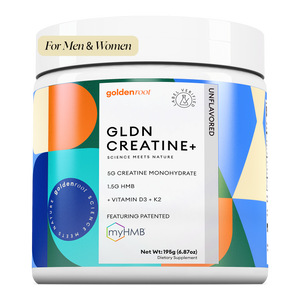Creatine typically begins working within 1-2 weeks. Loading can speed things up, but results like strength gains, muscle fullness, and improved recovery are possible with or without it.
What Is Creatine and Why Does It Matter?
Creatine is one of the most researched supplements in fitness and strength training. It’s found naturally in your body and in foods like red meat + fish, but supplementing allows you to fully saturate your muscles for better performance.
Why do people care? Because creatine delivers real, trackable changes, from weightlifting PRs to visual muscle definition.
And if you’re wondering whether you need to "load" creatine to see fast results, we’ll clear that up too.
This guide covers what to expect before and after creatine, how long it takes, loading pros and cons, and what kind of transformations are realistic.
##creatine-calc
What Happens to Your Body Before and After Creatine?
Creatine use is strongly associated with noticeable muscle growth when combined with strength training. After a loading phase, many experience increases in power and strength, along with better performance during short, high-intensity efforts.
Before Creatine Supplementation:
- Lower phosphocreatine levels
- Slower ATP regeneration (less energy for explosive movement)
- Less water inside muscle cells
- Slightly slower recovery between workouts
After Creatine Supplementation:
- Increased intramuscular water = fuller-looking muscles
- Improved high-intensity exercise performance
- Better workout recovery
- Noticeable gains in reps, sets, and lean mass
Most users begin seeing changes in strength or size within 2 to 4 weeks, depending on diet, training, and whether they load creatine or not.
Read more: Vitamin D3 and K2 for Bone Health: Protecting Your Skeleton on GLP-1 Medications
Do You Have to Do a Loading Phase with Creatine?
Short Answer: No, but it speeds things up.
What Is the Loading Phase?
The traditional loading phase involves taking 20g of creatine daily for 5-7 days (usually split into 4 doses). After that, you drop to 3-5g per day to maintain full muscle saturation.
Is Loading Required?
Not at all. You can take 3-5g daily from the start. It just takes a few more weeks to reach the same creatine levels in your muscles.
Pros of Loading:
- Faster muscle saturation
- Quicker increases in strength and performance
Cons:
- Temporary bloating
- Mild GI discomfort (especially if taking too much at once)
Science Says:
Both approaches are effective. Pick what feels best for your body.
Read more: how much water to drink with creatine
How Long Before You See Results with Creatine?
Creatine doesn’t work overnight, but the timeline is predictable.
Week 1:
- Slight increase in body weight (1-3 lbs), mostly from water retention
- Early signs of improved gym performance (extra reps, quicker recovery)
Weeks 2-3:
- Muscle fullness becomes more noticeable
- Strength improvements become consistent
- Better work output across sets
Weeks 4-6:
- Visual changes: muscle density, pump, and size
- Enhanced recovery between sessions
- More consistent energy in short, intense efforts
Beyond 6 Weeks:
- Gradual increases in lean muscle mass
- Improved training volume and progress
- Supports long-term physique and performance gains when combined with smart training and recovery habits
Read more: Creatine: Not Just for Muscles, A Boost for Your Brain Too
Creatine Before and After: What’s Realistic?
Not everyone adds 10 pounds of muscle in 6 weeks, but changes do happen, and they’re visible.
What You Might See:
- Fuller muscles in shoulders, arms, and legs
- Slight vascularity improvements
-
Increased definition when paired with fat loss or lean bulking
Keep in Mind:
- Diet, training intensity, sleep, and hydration play huge roles
- Creatine enhances performance; it doesn’t replace effort
- Everyone responds a bit differently based on baseline creatine levels, body type, and workout routine
Creatine Monohydrate vs HCL Before and After: Is There a Difference?
These are two of the most popular forms of creatine, but do they deliver different results?
Creatine Monohydrate:
- Most studied
- Budget-friendly
- May lead to water retention or bloating in some users
Creatine HCL (Hydrochloride):
- More soluble in water
- Typically easier on the stomach
- May cause less bloating for sensitive users
Read more: is creatine safe while breastfeeding
Performance Differences?
None that research confirms. Both forms saturate muscles and improve output. Choose the one your body tolerates better.
Bottom Line:
Go with what feels good and fits your budget. Results will mostly come from your training, not the label.
Read more: Optimizing Protein Intake on GLP-1 Medications: (How Much Do You Really Need)
What Happens If You Stop Taking Creatine?
Stopping creatine isn’t dangerous, but some changes may happen:
- Reduced water retention: Muscles may appear flatter after 1-2 weeks
- Slight drop in max strength output: Your ATP regeneration slows without saturated stores
- Muscle mass isn’t lost: Gains from consistent training remain, especially if protein and progressive overload continue
If you choose to cycle off creatine, taper rather than abruptly stopping, especially before competition or personal best attempts.
Scientific Evidence
- A 2017 review by the ISSN confirms creatine is effective for strength, performance, and muscle mass gains
- Long-term studies show no harmful side effects in healthy individuals
- Creatine supports high-intensity output and may even offer neuroprotective benefits, though more research is ongoing
Case Example:
In a 12-week study, participants who followed a creatine supplementation regimen {beginning with a 25 g/day loading phase for one week} , followed by a 5 g/day maintenance dose, combined with periodized heavy resistance training, experienced significant increases in strength performance.
Final Thoughts: What Can You Expect Before and After Creatine?
Creatine works. And whether you load or start slow, your strength, recovery, and appearance can noticeably improve over time.
It’s not a magic pill, but when paired with training, proper nutrition, and rest, it’s one of the simplest ways to enhance your results.
Try This:
Document your own before and after. Snap a few photos, log your lifts, and revisit in 6 weeks. You might be surprised how much changes there are.



